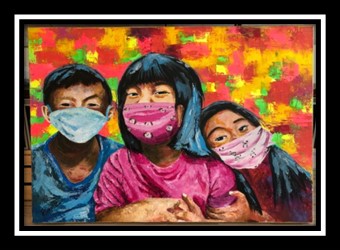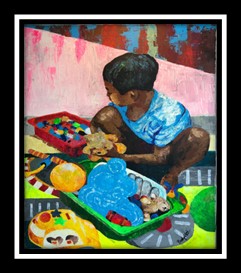Title: ‘Our Way of Fun During Covid Times’
Dimension: 78×102 cm/ 30×40 in’
Medium: Acrylic on canvas
Artist name: Precious Nakpil-Lai
Title: Masking Challenges: Children with Autism and the COVID-19 Pandemic
Introduction
The COVID-19 pandemic has brought about a host of challenges for people worldwide. One significant change has been the widespread use of face masks to prevent the spread of the virus. While masks have become a crucial tool in the fight against COVID-19, they have posed particular difficulties for children with autism. This essay explores the unique challenges faced by these children when it comes to wearing masks during these unprecedented times.
Understanding Autism
Autism Spectrum Disorder (ASD) is a complex developmental condition that affects social interaction, communication, and behavior. Children with autism often have sensory sensitivities and may struggle with changes in routines and environments. These factors make mask-wearing a particularly challenging task for them.
Challenges of Mask-Wearing for Children with Autism
- Sensory Sensitivities: Many children with autism have heightened sensitivities to sensory stimuli, including touch and texture. The sensation of a mask on the face, the elastic bands behind the ears, and the change in airflow can be overwhelming for them.
- Social Communication: Masks cover a significant portion of the face, obscuring facial expressions and lip movements, which are crucial for communication, especially for those who rely on visual cues. Children with autism often face difficulties in interpreting non-verbal communication, making mask-wearing an additional barrier to understanding others.
- Routines and Predictability: Children with autism thrive on routines and predictability. The sudden requirement to wear masks in various settings can disrupt their established routines, leading to anxiety and resistance.
- Anxiety and Fear: The mask-wearing mandate and the sight of others wearing masks can be anxiety-inducing for children with autism. They may not understand the reasons behind it and may find the masks frightening or confusing.
- Communication Challenges: Some children with autism may have limited verbal communication skills. For these children, expressing their discomfort or distress related to mask-wearing can be challenging, leading to frustration and meltdowns.
Strategies and Support
Recognizing and addressing the difficulties faced by children with autism in wearing masks is essential. Here are some strategies and forms of support that can help:
- Gradual Exposure: Gradually introduce mask-wearing in a controlled and supportive environment, allowing the child to acclimate to the sensation over time.
- Visual Supports: Use visual aids such as social stories or visual schedules to explain the importance of masks and how to wear them.
- Alternative Face Coverings: Some children may find face shields or transparent masks less intimidating since they allow for facial expressions to be seen.
- Sensory-Friendly Masks: Explore the use of sensory-friendly masks that are designed with soft materials and minimal seams to minimize discomfort.
- Education and Awareness: Educate caregivers, educators, and peers about autism and the challenges associated with mask-wearing to foster understanding and empathy.
Conclusion
The COVID-19 pandemic has presented a unique set of challenges for children with autism, particularly concerning mask-wearing. Recognizing the difficulties they face and providing support and accommodations are crucial steps in helping them adapt to this new normal. It is essential to balance public health measures with the needs and sensitivities of these children, ensuring that they can participate in society while feeling safe and understood.






Reviews
There are no reviews yet.